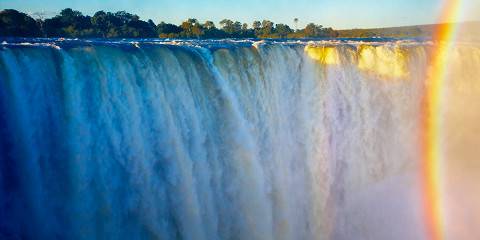
 DE
DE
35-50 years of age | Experience level: first safari
It was perfect. Best food we ever had in tanzania at Decken Camp and incredible experiences.
I would recommend Grassroots as a provider which is very friendly and helpfully.
We visited Udzungwa and Mikumi and it was a very nice experience! The campsides he offered are very nice too with very friendly staff. Hondo Hondo is wellknown and the best place to start to the waterfalls.
Decken Camp was very new, I think we were the 6th guests they had. Very, very friendly, clean and near to the Mikumi park. But the best was the food they offered. Everyone also the kids were excited!
We will come back as soon as possible next year.
 CA
CA
35-50 years of age | Experience level: first safari
I got help with gorilla permits!
My sister and I were planning an independent trip through southern Uganda and wanted to purchase gorilla and chimp permits in advance to make sure we didn't miss our chance to see them. After emails to many different companies and even the government agency that issues the permits, E-trip Africa was the only company that was helpful and responsive to our needs. For a reasonable fee, they arranged the purchase and delivery of the permits. I'm very grateful to Ben for all his help and knowledge. If I had gone with an organized tour, I would absolutely have chosen E-trip Africa simply because of their excellent customer service!
 NL
NL
20-35 years of age | Experience level: over 5 safaris
Walking with the rhino
My girlfriend and I have done the daytour to Motopos. Courtney was our guide. He really gave meaning to being guide. Following the tracks of the rhinos and searching for them in the bush. We found them and walked with them. That was a great experience. The scenic views of Motopos were also excellent. Courtney knows a lot and is very relaxed guide to be with.
 CH
CH
50-65 years of age | Experience level: first safari
Safari Selous & Ruaha
The arangements from flights, hotels and safaris were first class. We thank Rama for the booking and organization of the whole holiday. We will not hesitate to recommend Gecko Adventure Tanzania to friends and family.
Thanks for everything, and hope to see you in the future.
Urs
 US
US
35-50 years of age | Experience level: first safari
Maasai Legend Safaris is customer focused.
This safari company provided an amazing service. I visited Zanzibar in 2012 and I can't wait to return. The drivers spoke very clear English. Our consisted of seeing the 'big 5' and so much more. One of my favorite stops on the safari was the hippo pool. No question I will travel with this company again.
 AE
AE
35-50 years of age | Experience level: over 5 safaris
Amazing tour and safari.
I went to Kenya with my 2 kids last June. We picked the 9 days 8 nights safari.
Everything was organised perfectly and the tour itself was Amazing. Lucky, our driver, was very helpful in spotting animals and Always available to accomodate our requests.
The lodges selected by Kenya Expresso were all high level in terms of facilities and location.
I definitely reccommend Kenya Expresso!
Well done
 CH
CH
20-35 years of age | Experience level: 2-5 safaris
Great Time Traveling to Ruaha and Mikumi!
We had a great time on our 4 day 3 night safari from Dar to Ruaha then Mikumi before going back to Dar. Our driver, Samuel, was an excellent guide and was always looking out for us. The company offered us a package that was not so much on the 'luxury' side of safari experiences (though not on the shabby side either!) but that was good for us because it was much(!) more affordable than the other very expensive packages I was offered, a bit of an adventure, and still incredibly enjoyable. I'd recommend this company to other potential safari go-ers...and if we go back to TZ we will use them again.
 SE
SE
35-50 years of age | Experience level: first safari
2-Day Safari (Lake Manyara and Ngorongoro)
We traveled with Children and we only wanted a short Safari trip. We contacted many tour operators but finally we decided to go for Northern Circuit and we are glad we did. Northern Circuit arranged pick up at the airport, hotel (before, during and after the Safari) and arranged transport back to the airport for further adventures. Our plane was delayed with 10 hours. Instead of landing on the evening we landed early in the morning. Michael and his driver slept in the bus at the airport and when we arrived they stood outside the airport waiting for us. The guides were very friendly, knowledgeable and easy to talk with. We had two great days in Lake Manyara and Ngorongoro. The last night Michael came to our hotel and socialized with us and in the morning he came and sad good bye before we left. I strongly recommend Northern Circuit as your tour operator for your Safari.
 US
US
20-35 years of age | Experience level: over 5 safaris
They were the most convenient company I have never met
I'm from USA
Most friendly, the service was extremely perfect, living up to expectation was beyond what I expected , safari tours itself was fantastic.
( Overall was immensely good)
 NL
NL
50-65 years of age | Experience level: first safari
Our trip was outstanding. Very friendly drivers, excellent accomodations and perfect organisation
We had great expectations about our safari. Our Safari with Kenya Expresso Tours and Safari however exceeded those expecations. It was fantastic. Good communication, nice and friendly drivers and excellent service. I can´t name an item whatsoever to complain about.
